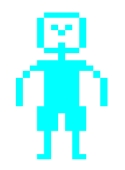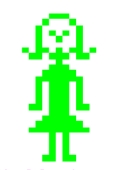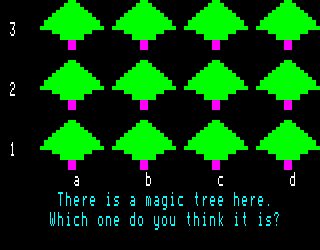This is my interview with the creator of the BBC Micro’s primary school cult classic Granny’s Garden. It was published on my retrogaming site in 2005.
It’s 1982, and the BBC has just made Acorn’s new computer the official BBC Microcomputer – which gave the chunky cream box an easy ride straight into schools up and down the UK.
Some classroom BBC Model Bs were ignored by suspicious luddite teachers; others had passionate lunchtime ‘Computer Clubs’ form around them. But, for some inexplicable reason, seemingly all of them — every single BBC Model B in the whole of Britain — had Granny’s Garden.
Mike Matson was a Devonshire teacher — specialism: geography — when he created the witch, the woodcutter’s cottage, the talking mushroom and the perplexing four-dragons puzzle, all of which will forever bounce around the brains of any UK citizen now approaching their 30th birthday. We tracked him down for a cup of tea and a chinwag about Granny’s Garden.
![]()
![]()
Mike Matson… then and now
How did you get into computing?
In the early ’80s I spent the weekend with a friend of mine who worked at Hewlett Packard, and he’d got this huge computer with a tiny little green screen, text-only. He asked me to come and have a look. So I sat down — and I was there glued to it the whole weekend. It was the original Adventure — gold nuggets, diamonds, dwarves — and it absolutely hooked me. This tiny little screen, no bigger than six inches, just got me. It was wonderful.
So what made you a programmer?
Around 1983, I was deputy head at a school in Devon. At an evening meeting I persuaded the Parent-Teacher’s Association to buy a computer for the school. The next day, the rest of the staff went ape. They were thinking about how many football shirts they could have bought with the money. From then on, the pressure was on to prove that this thing was worth having.
I looked at the software out there, and it was all written by people who had no idea how to motivate kids. So I got hold of my own BBC B, two weeks before the school, and decided to teach myself how to program. Just so there’d have some decent stuff ready for when the school’s computer arrived. That was how it started.
Which led to Granny’s Garden…
Well, Granny’s Garden basically came about because the UK government pledged a half-price computer to any school that had at least two members of staff trained to use it. I got a job with Devonshire County Council as an Advisory Teacher for Computers — which meant travelling around the 400 schools in Devon, giving computer courses for teachers who really didn’t want to know. One hour tutorials where 30 minutes was spent loading a game in off cassette tape, and then watching this awful rubbish on the screen. It was horrible.
I thought: I need to show them something more exciting. An actual adventure. 250 hours later, I had Granny’s Garden. I wanted to create something that was a starting point for children, something that would get them enthusiastic and using their imagination. Because back then you had just one computer for a whole school. So a game had to be designed for use in groups, 10-15 minutes each.
Did you send the finished product off to any publishers?
I was actually thinking about it, but there weren’t that many out there at the time who knew what they were doing. In the end a friend of mine, Neil Souch — who was looking for a way out of the fire service — said, “If you write thus stuff, I’ll sell it.” So we set up 4Mation between us. And it’s still going!
Do you remember how many copies you sold?
I think we lost count at around 20,000. Of course, most copies of Granny’s Garden were ripped off. I’m sure the illegal copies outnumbered the legal ones.
It really surprised me that so many people liked it. I think Granny’s Garden scored because it was so different to the other software that was around the time. It’s value was in — sounds a bit grand this — giving the world a pointer, an idea of how computers could be used. In the same way that Adventure sparked off my imagination, Granny’s Garden sparked off other people’s.
Did you receive any feedback from the millions of kids who played and loved the game?
Yeah, I used to get letters from kids — from whole classes of kids — and I’d try to reply to them all. It was a huge success in Australia and New Zealand, and I got to visit a school in Tasmania and see the kids’ Granny’s Garden work on the wall. I got a real buzz out of that.
And I still bump into people who remember the game. Over Christmas we had my wife’s nephew over for the day, and he brought his girlfirend with him. She’s 31 and a teacher. He asked her if she’d ever heard of Granny’s Garden, then told her she was sitting right next to the bloke who wrote it. Her face lit up!
What are you to up now?
I’m 58 now, and I still haven’t decided what I want to do when I grow up. I spent around 13 years making education software, then left 4Mation to do some web stuff, and worked for Apple as a Quicktime consultant. More recently I got into doing video, including quite a lot of stuff at a polo club — so I got to point the camera at a number of celebrities like Prince Charles and Esther Rantzen.
Right now, I’m working on a big multimedia project for the Botswana government. In fact I’ve just been to Edinburgh to film Alexander McCall Smith who has sold 7 million copies worldwide of his delightful “No.1 Ladies Detective Agency” novels set in Botswana. I fell in love with Botswana seven years ago when my daughter Esther was teaching there and took me to the Mokolodi Nature Reserve. The park manager got me totally inebriated and persuaded me to set up a website and maintain it for the rest of my life! But I’m not complaining. My wife and I were made Honorary Lifetime Volunteers last year and feel as much at home at Mokolodi as we do in the UK.
Wait a minute… Esther? She was one of the six childen you had to rescue in Granny’s Garden…
Yes, the first two children — Tom and Esther — are my own kids. They’re all grown-up now, but they were tiny at the time. Another two were Neil Souch’s kids… and I can’t remember where the names for the final two sprang from.




Tom and Esther… then and now.
Granny’s Garden: Director’s Commentary
Mike racks his brain to explain the reasoning behind the best-remembered bits of Granny’s Garden
The Magic Tree
Random tree-guessing nightmare was the door to a world of pixellated, BASIC adventure.
Mike: “What the hell did you have to do here? You had to pick a tree, right? The grid must have been there for ‘educational’ reasons. I seem to remember a few people found this frustrating. I’d forgotten about it completely, to be honest.”
The Raven
Your guide throughout the game; told you off if you said ‘No’ when asked for help.
Mike: “The BBC’s graphics were so limited. I probably decided I wanted a bird — because birds talk, don’t they? Minah birds, parrots talk… so I started drawing a bird, and then decided I could get away with calling it a raven. And there’s the whole Tower of London thing: ravens are special.”
The Witch
Argh! Her appearance meant game over. Repressed terror-memory of ’80s children everywhere.
Mike: “My least favourite bit. For years I’ve felt really bad for perpetuating the myth that witches are bad people. Because they ain’t. I’ve met a number of witches, and they’ve all been delightful people. They’re good people. They want to save the planet.”
The Dragons
Puzzle involving feeding chips and oranges to baby dragons. Stumped everyone.
Mike: “My favourite part: just because it was the most difficult section to get working. But I often got comments about “those bloody dragons”. The trick was getting each dragon out on its own. It wasn’t supposed to be that hard – it was only when I went back to it later and found I couldn’t do it that I realised it was too hard. I was cursing those bloody dragons as much as all the kids across the country.”
The Land of Mystery
Mini graphical adventure with giants, forest fires, and a key-eating creature called Redhorn.
Mike: “My tribute to that old Adventure game I played. Because I was a geography specialist, I had to get a map in there somewhere. As for the Castle of Illusions [where the screen would go nuts for a couple of minutes before the final child was found], I think I was just showing off. I probably read an article in a magazine about how to create these wonderful effects, so I just threw them in. I’m a child of the ’60s, too, so you’ve got to have your psychadelic stuff.”




